| Columns Retired Columns & Blogs |
Triangle Signature Delta loudspeaker Measurements
Sidebar 3: Measurements
I used DRA Labs' MLSSA system and a calibrated DPA 4006 microphone to measure the Triangle Signature Delta's frequency response in the farfield, and an Earthworks QTC-40 for the nearfield and spatially averaged room responses. My estimate of the Signature Delta's voltage sensitivity was 91.8dB(B)/2.83V/m, which is both much higher than average and basically agrees with the manufacturer's specification of 92dB. The Triangle's electrical impedance and electrical phase angle are shown in fig.1 (solid and dashed traces, respectively). The Delta is a much kinder load than Triangle's Magellan Concerto, which was reviewed in March 2005 (see fig.1 here), with an impedance that stays above 6 ohms for much of the audioband. However, with a minimum value of 2.87 ohms at 115Hz and a combination of 3.8 ohms and –46° at 82Hz, a frequency where music typically has high energy, an amplifier capable of driving 4 ohms with aplomb is recommended.
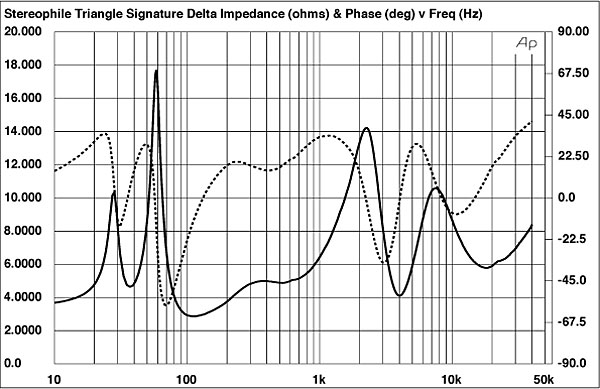
Fig.1 Triangle Signature Delta, electrical impedance (solid) and phase (dashed) (2 ohms/vertical div.).
When resonances of various kinds are present in a speaker's enclosure, these reveal their existence by giving rise to discontinuities in the traces in a plot of the speaker's impedance against frequency. (See "The Sound of Surprise.") The Signature Delta's traces were almost entirely free from such discontinuities, but there is a very slight wrinkle near 600Hz. Using a simple plastic-tape accelerometer (similar to a piezoelectric acoustic-guitar pickup), I found a resonant mode at 582Hz on both the rear panel and the sidewalls (fig.2). Though I could hear the effect of this mode with a stethoscope while music was playing, it was low enough in level and high enough in frequency that it probably will not affect the sound quality.
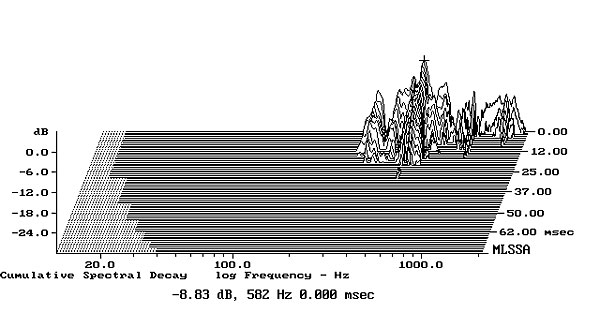
Fig.2 Triangle Signature Delta, cumulative spectral-decay plot calculated from output of accelerometer fastened to center of side panel level with midrange unit (MLS driving voltage to speaker, 7.55V; measurement bandwidth, 2kHz).
Fig.3 shows the individual responses of the tweeter and midrange unit (blue trace), the woofers (green), and the port (red). The low-frequency saddle centered on 37Hz in the impedance-magnitude trace suggests that this is the tuning frequency of the large, divided port on the front panel. This is confirmed by the fact that the minimum-motion notch in the woofers' output occurs at the same frequency, though the port's output actually peaks a little higher in frequency. The port's upper-frequency response is commendably free from resonant peaks, though both its low-frequency rolloff and that of the woofers is closer to 18dB/octave than the usual 12dB. This suggests the presence of a large series capacitor in the woofer connection, to reduce the level of infrasonic spuriae.
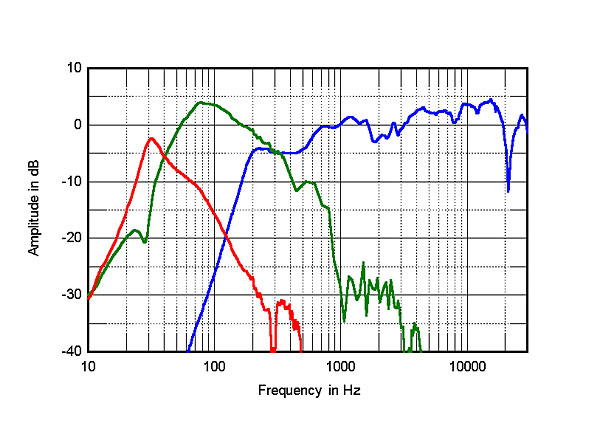
Fig.3 Triangle Signature Delta, acoustic crossover on tweeter axis at 50", corrected for microphone response, with nearfield responses of midrange unit (blue), woofers (green), and port (red), respectively plotted below 500Hz, 350Hz, 490Hz.
The two woofers have the same response (fig.3, green trace) and cover a relatively narrow bandpass, between 55 and 190Hz. Though some breakup behavior is visible between 500Hz and 4kHz, this is well suppressed by the crossover. The midrange unit (fig.3, blue trace) rolls off steeply below 200Hz, and its output rises gently toward its handoff to the tweeter. The tweeter itself appears to be balanced a couple of dB too high in level, and there is a sharply defined notch in its output just above 20kHz. Both characteristics persist in the plot of the Signature Delta's response averaged across a 30° horizontal window centered on the tweeter axis (fig.4). The apparent rise in the upper bass is almost entirely due to the nearfield measurement technique; the low bass rolls off very quickly below 30Hz. While the midrange and treble have many small dips and peaks, the overall trend is very even.
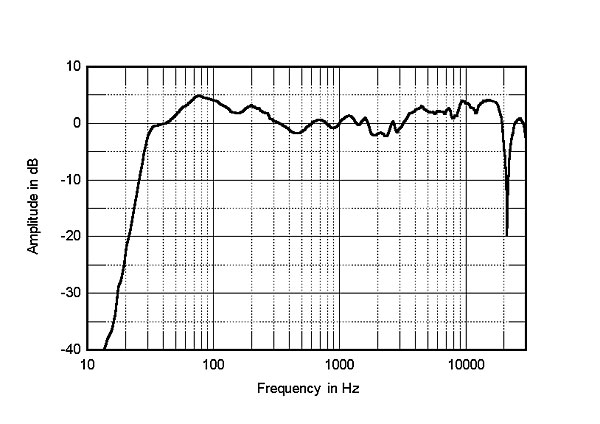
Fig.4 Triangle Signature Delta, anechoic response on tweeter axis at 50", averaged across 30° horizontal window and corrected for microphone response, with complex sum of nearfield responses plotted below 300Hz.
You can't predict a speaker's tonal balance from its anechoic or quasi-anechoic behavior on the tweeter axis, as that will also depend on the dispersion. Fig.5 shows the Triangle's horizontal dispersion, normalized to the tweeter-axis response. Other than some small off-axis irregularities, the radiation pattern is superb, with evenly spaced contour lines and a progressive rolloff of the top two octaves to the speaker's sides. In a typically sized room with the usual furnishings, this dispersion will compensate for the "hot" on-axis tweeter level to give a well-balanced treble, as I found in my listening. In the vertical plane (fig.6), a severe suckout develops above the tweeter axis at the upper crossover frequency (shown by the cursor position to be very close to the specified 2.7kHz), but as this axis lies a high 47" from the floor, this will not be a problem. The response changes only slightly up to 15° below the tweeter axis, which is a good thing, given that average ear height of a seated listener is about 36".
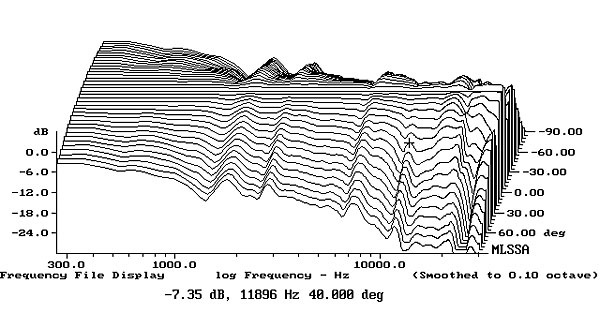
Fig.5 Triangle Signature Delta, lateral response family at 50", normalized to response on tweeter axis, from back to front: differences in response 90–5° off axis, reference response, differences in response 5–90° off axis.
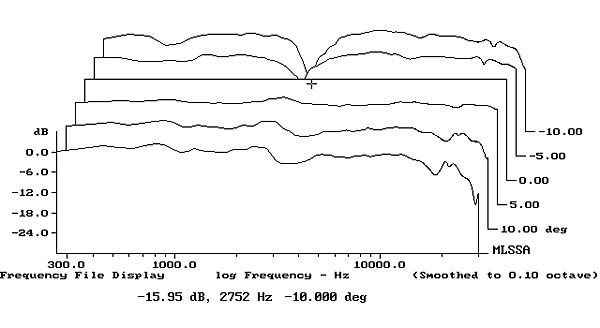
Fig.6 Triangle Signature Delta, vertical response family at 50", normalized to response on tweeter axis, from back to front: differences in response 10–5° above axis, reference response, differences in response 5–15° below axis.
I measured the Triangle speakers' spatially averaged response at the listening position. (I average 20 1/6-octave–smoothed spectra, taken for the left and right speakers individually using SMUGSoftware's FuzzMeasure 3.0 program and a 96kHz sample rate, in a rectangular grid 36" wide by 18" high and centered on the positions of my ears.) The result is shown as the red trace in fig.7; also shown, for reference, is the response of the Joseph Audio Perspective tower speaker (blue). The two speakers offer similar behavior in the high treble and midrange, though the Triangle's low-frequency behavior suits my room acoustic significantly better than the Joseph's, whose bass would be better balanced in a room larger than mine. The other difference is in the presence region: the Joseph has a bit too much energy in-room between 2 and 6kHz, which made it a tad fussy about system matching. By contrast, the Triangle has a slight depression visible between 1.5 and 3kHz.
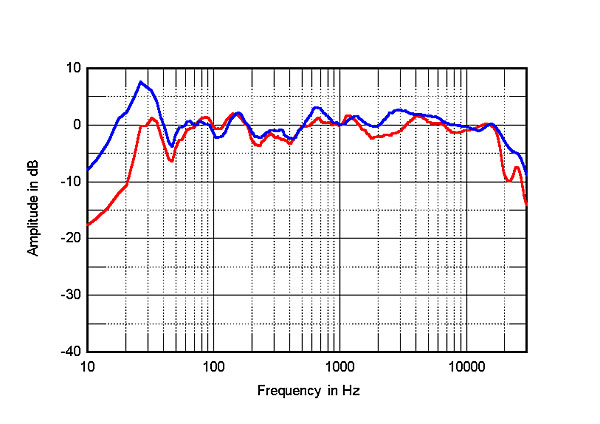
Fig.7 Triangle Signature Delta, spatially averaged, 1/6-octave response in JA's listening room (red); and of Joseph Audio Perspective (blue).
Turning to the time domain, fig.8 shows the Triangle's step response on its tweeter axis. The tweeter and midrange drive-units are connected in inverted acoustic polarity, the woofers in positive polarity. Importantly, the decay of each unit's step blends smoothly with the start of that of the next lower in frequency, implying optimal crossover design. The cumulative spectral-decay or waterfall plot on the tweeter axis (fig.9) is impressively clean throughout the treble, though a couple of low-level ridges of delayed energy are visible in the low treble.
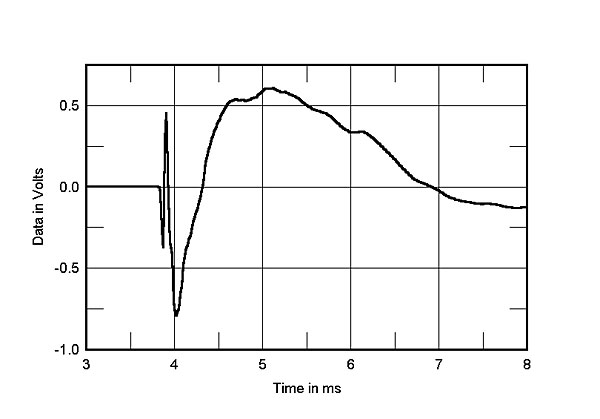
Fig.8 Triangle Signature Delta, step response on tweeter axis at 50" (5ms time window, 30kHz bandwidth).
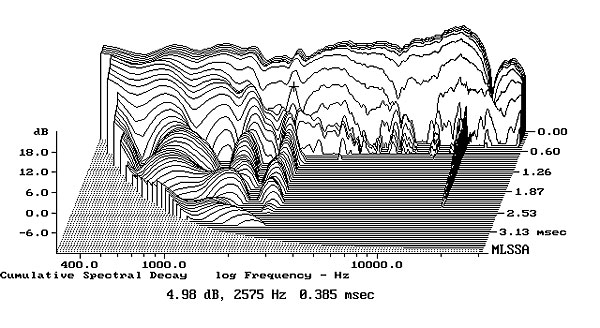
Fig.9 Triangle Signature Delta, cumulative spectral-decay plot on tweeter axis at 50" (0.15ms risetime).
Overall, its measured performance suggests that Triangle's Signature Delta is a well-engineered, well-optimized loudspeaker.—John Atkinson
- Log in or register to post comments




































